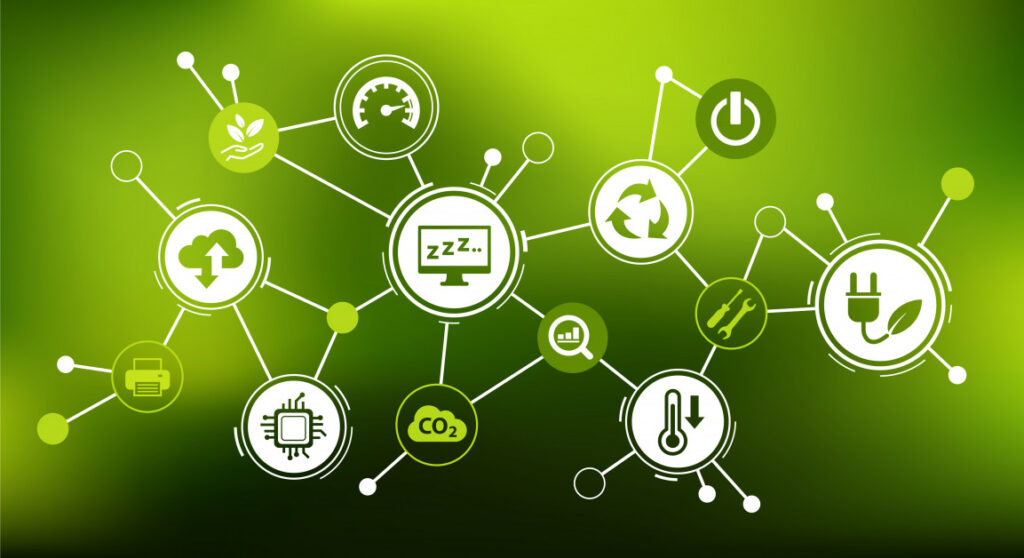Table of Contents
Introduction:
In the era of increasing environmental concerns, industries across the globe are turning to sustainable practices. The IT sector, being a major energy consumer, is no exception. Green computing is emerging as a solution to minimize the ecological footprint of information technology. This blog explores what green computing is, how it works, and how it’s making a significant difference in reducing the environmental impact of IT systems.

What is Green Computing?
Green computing, or green IT, refers to the environmentally responsible use of computers and IT resources. Green computing aims to design, manufacture, use, and dispose of computing devices with minimal or no impact on the environment. It involves implementing energy-efficient technologies, reducing electronic waste, and using sustainable resources.
Key components of green computing include:
- Energy-efficient hardware: Designing computers and data centers that consume less power.
- Cloud computing: Reducing physical hardware by utilizing virtual environments.
- Sustainable manufacturing: Using eco-friendly materials and processes in production.
- Recycling and e-waste management: Ensuring proper disposal and recycling of outdated or broken hardware.

How Can We Reduce the Environmental Impact of Computers?
Reducing the environmental impact of computers requires a holistic approach across the entire lifecycle of IT equipment, from manufacturing to disposal. Some practical ways include:
- Energy-efficient hardware: Opting for devices certified by standards like ENERGY STAR can significantly reduce power consumption. Low-power processors, solid-state drives (SSD), and energy-saving monitors can help conserve energy.
- Virtualization and cloud computing: Shifting workloads to virtual machines reduces the need for physical hardware. Cloud computing platforms allow businesses to scale without adding more servers, lowering their overall environmental impact.
- Optimized software and algorithms: Efficient coding and software optimization can help reduce the computational power required, lowering energy consumption.
- Power management: IT departments can implement power-saving techniques such as automatic shutdown of unused machines and reducing idle power draw with advanced power management settings.
- Sustainable disposal practices: Recycling or donating obsolete equipment and adopting e-waste management protocols prevent harmful materials from polluting the environment.

How is Using Green IT Helping the Environment?
Green IT strategies not only reduce energy consumption but also positively impact the environment in various ways:
- Lower Carbon Emissions: By consuming less energy, green IT reduces the carbon footprint of data centers, office systems, and home computing. This decrease in energy demand reduces reliance on fossil fuels, thereby lowering CO2 emissions.
- Reduction in E-Waste: Green computing encourages the reuse, refurbishing, and recycling of hardware components. Effective e-waste management ensures fewer hazardous materials such as lead and mercury end up in landfills.
- Sustainable Data Centers: Companies are adopting green data centers that use renewable energy sources, such as solar or wind power, to reduce energy usage and their environmental impact.
- Extended Product Life: Green IT promotes manufacturing practices that produce durable, energy-efficient hardware with a longer lifespan, reducing the need for frequent replacements and minimizing resource extraction.

Use Case Studies:
- Google’s Sustainable Data Centers: Google is leading the way in green computing with its environmentally friendly data centers. By using AI-driven cooling systems, Google has improved the energy efficiency of its data centers, reducing its overall energy consumption by 30%. Additionally, Google has committed to using 100% renewable energy for its operations.
- Dell’s Sustainable Manufacturing: Dell has implemented green computing by using recyclable materials in its computers and adopting eco-friendly packaging. Dell’s efforts to reduce carbon emissions in the production process and responsibly manage e-waste have set a new standard for sustainability in tech manufacturing.
- IBM’s Energy-Efficient IT Solutions: IBM has developed energy-efficient servers and data storage solutions that help businesses reduce their power usage. IBM’s green IT initiatives have led to cost savings for clients and decreased environmental impact through energy conservation.
Conclusion:
Green computing is more than just a trend; it’s a crucial strategy for reducing the environmental impact of the growing IT sector. By adopting energy-efficient hardware, implementing better e-waste practices, and using sustainable IT solutions, businesses and individuals can contribute to a more sustainable future. Green IT is helping to reduce carbon emissions, minimize e-waste, and promote a healthier planet for future generations.
How does green computing benefit the environment?
Green computing helps reduce energy consumption, lower carbon emissions, decrease e-waste, and conserve natural resources. By adopting energy-efficient technologies and sustainable practices, green IT minimizes the ecological footprint of computers and data centers, contributing to environmental preservation.
What are the key strategies of green computing?
Green computing strategies include:
1. Using energy-efficient hardware and software.
2. Implementing cloud computing and virtualization to reduce physical infrastructure.
3. Recycling and managing e-waste responsibly.
4. Encouraging sustainable manufacturing processes.
5. Optimizing power management and reducing idle energy consumption.
How can we reduce the environmental impact of computers?
You can reduce the environmental impact of computers by:
1. Choosing energy-efficient devices certified by standards like ENERGY STAR.
2. Switching to cloud computing and virtual environments to minimize physical hardware.
3. Recycling old hardware and properly managing e-waste.
4. Using efficient software and applying power management settings to reduce energy use
What is e-waste, and how does it affect the environment?
E-waste refers to discarded electronic devices such as computers, phones, and other tech gadgets. Improper disposal of e-waste can lead to the release of hazardous substances like lead, mercury, and cadmium into the environment, contaminating soil, water, and air. Green computing emphasizes responsible e-waste management to prevent environmental pollution.
What is e-waste, and how does it affect the environment?
E-waste refers to discarded electronic devices such as computers, phones, and other tech gadgets. Improper disposal of e-waste can lead to the release of hazardous substances like lead, mercury, and cadmium into the environment, contaminating soil, water, and air. Green computing emphasizes responsible e-waste management to prevent environmental pollution.